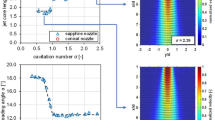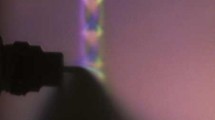Abstract
There has never been any fundamental explanation presented for the transition from the bubbling regime to the jetting regime when gas is injected into liquid at high velocity through submerged tuyeres. This is an important issue in metallurgical processes, since the flow regime is known to influence refining rates, refractory erosion, and the penetration of the liquid into the tuyere. Based on the observation that many small droplets of liquid and gas bubbles are formed to create the jets, a combined Kelvin-Helmholtz and Rayleigh-Taylor instability analysis has been applied to bubbles forming at submerged tuyeres. For particular wavelengths of disturbances, the interface will be unstable and create bubbles and droplets. The critical injection velocity for instability depends on surface tension, tuyere diameter, and the gas-to-liquid density ratio, which can be summarized by We = 10.5(ρ*)−1/2, where We is the Weber number based on the gas velocity and density and tuyere diameter, and ρ* is the gas-to-liquid density ratio. The importance of surface tension had not been appreciated previously for this regime of gas injection. There is considerable controversy in the literature concerning the measurement of the transition from bubbling to jetting. The 70 pct “linking” point, proposed by Ozawa and Mori, describes the situation where 70 pct of the bubbles link with the preceding bubbles and produce a reasonably steady jet. The theoretical correlation developed above predicts the velocity to reach this point ±20 pct (95 pct confidence level) in a variety of systems from six different groups of workers. The theoretical analysis demonstrates that the instabilities are primarily capillary in nature, not gravity waves, which explains the observation that orientation has little effect on the jetting transition.
Similar content being viewed by others
Abbreviations
- C g :
-
growth factor coefficient (-)
- c r :
-
speed of propagation of waves (m/s)
- d :
-
bubble diameter in Eqs. [10] and [11] (m)
- d o :
-
diameter of nozzle (m)
- d* :
-
dimensionless diameter in Eq. [16] (-)
- Fr:
-
Froude number,U 2/g/d o (-)
- Fr′:
-
modified Froude number,ρU2/(ρi - ρg)/g/do (-)
- g:
-
gravitational acceleration (m/s2)
- h :
-
thickness of fluid layers (m)
- k :
-
wave number (1/m)
- k m :
-
minimum wave number (1/m)
- Re:
-
pipe Reynolds number,ρ g Ud o /μ g (-)
- Reb :
-
bubble Reynolds number, ρl,Ud/μl (-)
- Q :
-
volumetric flow rate (m3/s)
- t g :
-
disturbance growth time (s)
- t p :
-
propagation time for disturbance (s)
- U :
-
velocity (m/s)
- U o :
-
gas velocity at nozzle (m/s)
- V b :
-
bubble volume (m3)
- We:
-
Weber number, ρgU 2o do/σ (-)
- θ :
-
angle from front stagnation point (deg)
- μ :
-
viscosity (kg/m/s)
- ρ :
-
density (kg/m3)
- σ :
-
surface tension (kg/s2)
- g :
-
gas
- l :
-
liquid
- o :
-
diameter or starting
- s :
-
separation
References
M. Sano and K. Mori:Trans. Jpn. Inst. Met., 1976, vol. 17, pp. 344–52.
G.A. Irons and R.I.L. Guthrie:Can. Metall. Q., 1981, vol. 19 (4), pp. 381–87.
J.F. Davidson and B.O.G. Schuler:Trans. Inst. Chem. Eng., 1960, vol. 38, pp. 144–54.
R. Kumar and N.R. Kuloor:Adv. Chem. Eng., 1970, vol. 8, pp. 255–68.
R. Clift, J.R. Grace, and M.E. Weber:Bubbles, Drops and Particles, Academic Press, New York, NY, 1978.
A. Jeje, B. Ross, and D. Koon: University of Calgary, Alberta, Canada, unpublished research, 1989.
E.O. Hoefele and J.K. Brimacombe:Metall. Trans. B, 1979, vol. 10B, pp. 631–48.
Y. Ozawa and K. Mori:Trans. Iron Steel Inst. Jpn., 1986, vol. 26, pp. 291–97.
A.E. Wraith and M.E. Chalkley: inAdvances in Extractive Metallurgy, M.J. Jones, ed., IMM, London, 1977, pp. 27–33.
I. Leibson, E.G. Holcomb, A.G. Cacoso, and J.J. Jacmic:AICh E J., vol. 2 (3), pp. 296–306, Sept. 1956.
M. Sano and K. Mori:Trans. Iron Steel Inst. Jpn., 1986, vol. 20, pp. 675–81.
J. Szekely:Fluid Flow Phenomena in Metals Processing, Academic Press, New York, NY, 1979.
J. Kitscha and G. Kocamustafaogullari:Int. J. Multiphase Flow, 1989, vol. 15 (4), pp. 573–88.
S. Chandrasekhar:Hydrodynamic and Hydromagnetic Stability, Oxford University Press, Oxford, United Kingdom, 1961.
R. Clift, J.R. Grace, and M.E. Weber:Ind. Eng. Chem. Fundam., 1974, vol. 13, pp. 45–51.
M.J. McNallan and T.B. King:Metall. Trans. B, 1982, vol. 13B, pp. 165–73.
K. Mori, Y. Ozawa, and M. Sano:Trans. Iron Steel Inst. Jpn., 1982, vol. 22, pp. 377–84.
J.O. Hinze:AIChE J., 1955, vol. 1 (3), pp. 289–95.
A.H. Lefebvre:Atomization and Sprays, Hemisphere Publishing Corp., New York, NY, 1989.
L.R. Farias and G.A. Irons:Metall. Trans. B, 1985, vol. 16B, pp. 211–25. $
Author information
Authors and Affiliations
Rights and permissions
About this article
Cite this article
Zhao, Y.F., Irons, G.A. The breakup of bubbles into jets during submerged gas injection. Metall Trans B 21, 997–1003 (1990). https://doi.org/10.1007/BF02670270
Received:
Issue Date:
DOI: https://doi.org/10.1007/BF02670270




